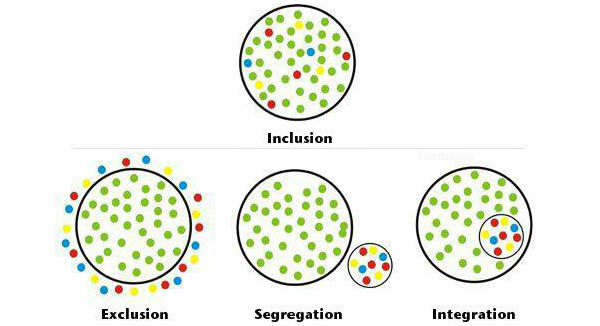
Inclusion: What It Is And What It Isn't
Last week I wrote about inspirational media and inclusion of people with disabilities, which led me to realize that many do not understand what inclusion is and what it looks like.
There are plenty of situations that appear to be examples of inclusion at first glance, but are not inclusive at all. Those inspirational stories and images fall into that category. So today I’ll try to explain what inclusion isn’t - and what it is - with real everyday examples.
Segregation
Defintion: the separation or isolation of a race, class, or ethnic group by enforced or voluntary residence in a restricted area, by barriers to social intercourse, by separate educational facilities, or by other discriminatory means.
Example: Segregation is a deliberate separation with physical facilities or social structures intended for the use of one group but not the other. In the world of disabilities, this usually means group homes or separate schools.
Integration
Definition: incorporation as equals into society or an organization of individuals of different groups.
Example: When a small group becomes part of a larger group, it doesn’t necessarily mean that the two groups intermingle or that the smaller group is included in activities. I’ve seen this happen most often in the school cafeteria and at family get-togethers.
In the cafeteria scenario, the students with special needs sit together and do not interact with general education students. In the family party scenario, caregivers remain with the person with special needs while other family members leave them alone, so even though they’re technically “at” the party, they’re not “with” the party.
A friend of mine who has a large extended family told me, “I wish that just once someone would spend time with us at a party or give me a chance to say hello to everyone.”
Exclusion
Definition: a keeping apart; blocking of an entrance. (dictionary.com)
Example: Exclusion may be deliberate or accidental, but the end result is the same: a person with a disability cannot access buildings or activities like everyone else. A person may be unable to enter a park or building because of physical barriers. Or a person may be advised not to participate in a class, team sport or extracurricular activity because of his or her disability.
One of my neighbors was told not to sign up for After-School Science because he required too much extra attention. Barriers may also be sensory-based. My family often has to leave events if the event organizers refuse to turn down the volume on the speakers or amplifiers.
Inclusion
Definition: The act of including.
Inclusion means that a person with a disability has the same rights, access and choices as everyone else in a community. Inclusion is now considered a universal human right.
Article 19 of the UN Convention on the Rights of Persons With Disabilities states, “Parties to this Convention recognize the equal right of all persons with disabilities to live in the community, with choices equal to others, and shall take effective and appropriate measures to facilitate full enjoyment by persons with disabilities of this right and their full inclusion and participation in the community.”
Inclusion Done Right
Network Learning, a volunteer-run organization in the Netherlands, elaborates even further on the meaning of inclusion. “Inclusion is recognizing our universal ‘oneness’ and interdependence. Inclusion is recognizing that we are ‘one’ even though we are not the ‘same.’ The act of inclusion means fighting against exclusion and all of the social diseases that exclusion gives birth to – racism, sexism etc. Fighting for inclusion also involves assuring that all support systems are available to those who need such support – as a civic responsibility, not a favour. We were all born ‘in.’”
Examples of Inclusion
Inclusion comes in many forms, and ideally, we don’t even notice that it is happening because it should be an organic part of community-building. Here are 10 examples of inclusion that I have personally seen:
1. A group of children volunteer to pack boxes of food at a local food pantry.
2. Students help each other find books in the library.
3. A customer, cashier and grocery bagger chat at the store.
4. People participate in religious services together.
5. A physician listens to a patient’s concerns and speaks directly to the patient.
6. Students take turns giving brief presentations on their research projects in social studies class.
7. Families swim together at the city pool.
8. A family rides roller coasters at a theme park.
9. Families shop together at a farmer’s market and stop to listen to a live music performance.
10. A movie theater is sold out because for this one show, the volume is turned down, the previews are cut and the lights are kept on low.
In other words, inclusion looks like normal, everyday life that all of us share with each other. Once we realize that inclusion enriches everyone’s quality of life, it becomes shocking to see it denied to any person. I hope to witness many more examples of inclusion in 2014.
If you have additional examples of segregation, integration, exclusion and inclusion, please share them in the comments.



